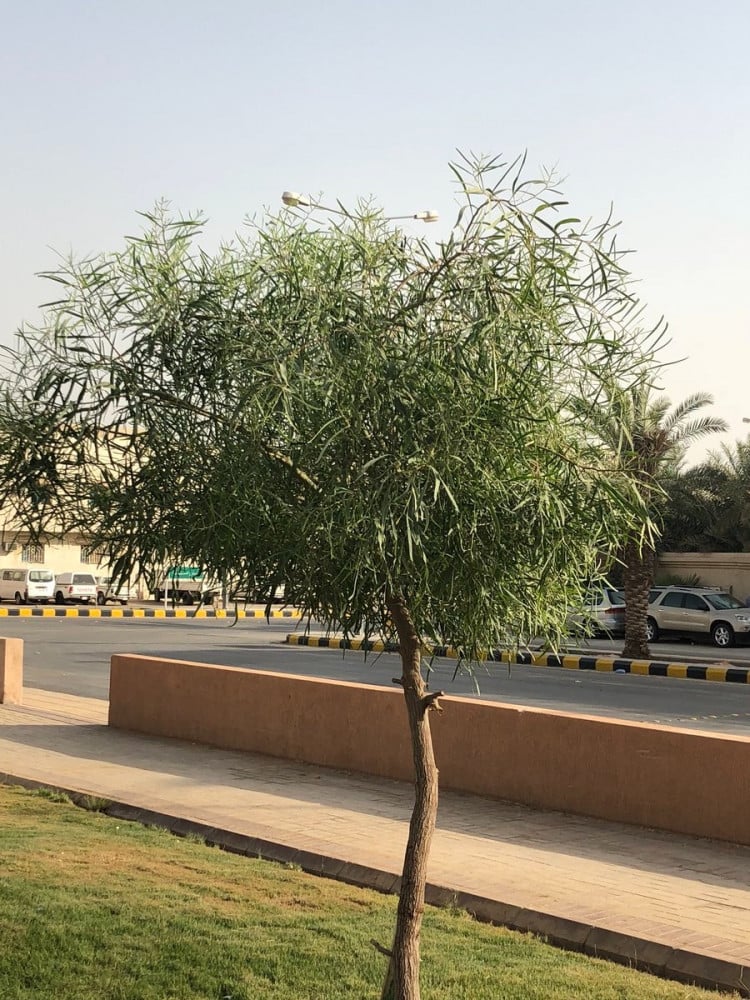الإسم الشائع : السنط الملحي.
الإسم العلمي : Acacia ampliceps
السنط الملحي شجرة طويلة أو شجيرة، مدخلة حديثاً في منطقة الخليج العربي، وموطنها الأصلي أستراليا حيث تنمو هناك على امتداد مجاري المياه أو في بطون الأودية والشعاب وقنوات الصرف،في الأماكن التي تكرث فيها التلال في الترب الثقيلة المالحة والقلوية.
وتتشابه هذه الظروف مع بعض الأودية والروضات في منطقة الرياض حيث تتجمع مياه الأمطار شتاء. وهونبات سريع النمو غير أنه لا يعمر طويلاً وفي الغالب لا يزيد عمره عن 50 عاماً.
وللنبات طبيعة نمو منتشرة إذ يتفرع قرب سطح التربة. وفي بعض الأحيان يكاد يكون مفترشاً. وغصينات النبات نحيلة متدلية،والسويقات
الورقية خضراء فاتحة اللون. والأزهار تظهر في نورات رأسية بيضاء إلى كريمية اللون كروية الشكل، وقد كان إلى عهد قريب التباس كبير في التفريق بين هذا النوع والسنط الصفصافي، السنط الملحي شديد التحمل للملوحة، إلا أنه حساس للصقيع. ويتأثر النبات بالإصابات الحشرية.
يتكاثر بالبذور. قد يصبح القطع ضرورة لصيانة النبات. وللأغراض التنسيقية، فإن طبيعة النمو الكثيفة تجعله ملائماً ليكون نباتاً ساتراً.
نموه المفترش أحياناً يجعله صالحاً بوصفه نبات تغطية للتربة. يحد من استخدامهقرب المسطحات الخضراء على سبيل المثال.
قد أظهرت دراسات إقليمية أن لهذا النبات قدرة كامنة للاستخدام في مشاريع استصلاح السبخات وبوصفه مصداً منخفضاً للرياح واستصلاح الكثبان والحد من التعرية. كما يصلح علفاً في المناطق الجافة.
يمكن لهذا النبات تحمل الجفاف لفترة تصل إلى 9 أشهر.
Salt acacia is a tall tree or shrub, newly introduced in the Arabian Gulf region, and its original home is Australia, where it grows along waterways or in the stomachs of valleys, reefs and drainage channels, in places where hills abound in heavy, saline and alkaline soils. These conditions are similar to some valleys and kindergartens in the Riyadh region, where rainwater collects in winter. This plant can withstand drought for up to 9 months. Acacia is a fast-growing plant, but it does not have a long lifespan, and it is usually less than 50 years old. The plant has a diffuse growth nature as it branches near the soil surface. Sometimes it is almost a predator. The stems of the plant are slender drooping, and the leafy stems are light green in color. The flowers appear in white to cream-colored, spherical vertical inflorescences. Until recently, there was a great deal of ambiguity in the distinction between this species and acacia, salty acacia that is very tolerant to salt, but it is sensitive to frost. The plant is affected by insect infestations. And it propagates with seeds. Cutting may become a necessity for plant maintenance. For coordination purposes, the dense nature of the growth makes it suitable as a cover plant, while its occasional spreading growth makes it suitable as a soil cover plant. It limits its use near green areas, for example. Regional studies have shown that this plant has a potential potential for use in marsh reclamation projects and as a low windbreak, dune reclamation and erosion reduction. It is suitable as fodder in dry areas.


